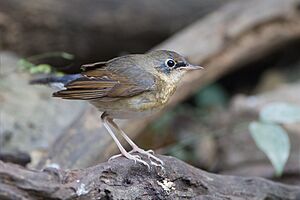Siberian blue robin facts for kids
Quick facts for kids Siberian blue robin |
|
|---|---|
 |
|
| Male | |
 |
|
| Juvenile | |
| Conservation status | |
| Scientific classification | |
| Genus: |
Larvivora
|
| Species: |
cyane
|
| Synonyms | |
|
Luscinia cyanea (lapsus) |
|
The Siberian blue robin (Larvivora cyane) is a small bird known for its beautiful blue feathers. It's a type of passerine bird, which means it's a perching bird. This robin used to be grouped with thrushes. Now, scientists usually place it in the Old World flycatcher family. Some similar small birds in Europe are called chats. The name Larvivora means "caterpillar eating" in Neo-Latin. The word cyane is Latin for "dark-blue," describing the male bird's color.
Contents
About the Siberian Blue Robin
Where Do Siberian Blue Robins Live?
This robin is a migratory bird. This means it travels long distances each year. It spends its breeding season in the eastern Palearctic region. This area includes places like Siberia, northern Mongolia, northeastern China, Korea, and Japan. When winter comes, these birds fly south. They spend the colder months in southern and southeastern Asia, including Indonesia.
What is Their Habitat Like?
Siberian blue robins like to live in coniferous forests. These are forests with trees like pine and spruce. They prefer areas with thick bushes and plants on the ground. You can often find them near rivers or at the edges of woodlands. They usually look for food on the ground. However, they are very shy and like to stay hidden. In winter, they also prefer to stay in dense plants.
What Do Siberian Blue Robins Look Like?
This bird is a bit bigger than the European robin. The male Siberian blue robin is easy to spot during breeding season. He has bright blue feathers on his back and white feathers on his belly.
The female robin looks quite different. She is much duller in color. Her upper body is brown, and her belly is whitish. Her dark eye stands out against her lighter brown face.
Are They Found in Europe?
The Siberian blue robin is very rarely seen in Europe. It's considered a "vagrant" bird there. This means it has flown far off its usual path. It's even rare to see them as far east as Pakistan.


